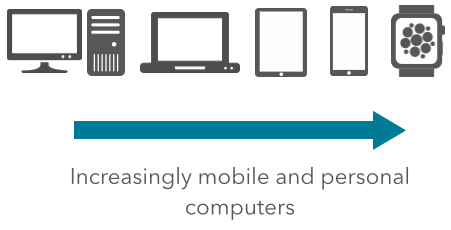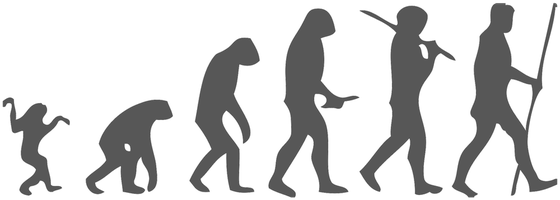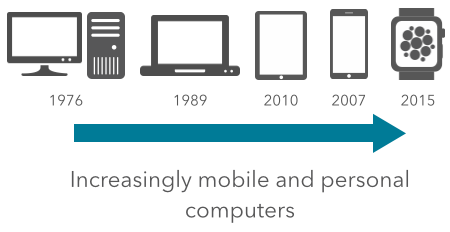On the morning of Apple’s latest iPad event, I wanted to quickly revisit the topic of iPad sales and share an idea that’s come up again and again as I’ve discussed the topic with other analysts and with reporters in the runup to today’s event. I’ve posted the video below to YouTube as a way of illustrating this idea visually, and the text below is largely the transcript of the video, with some of the same images used to illustrate key points. I’d love your feedback on the video format and on the blog post, as always. Feel free to connect with me on Twitter at @jandawson or to email me at jan@jackdawresearch.com.
(you may want to watch the video on YouTube.com to see it bigger, and whether you watch it here or there I suggest switching to the highest available resolution.)
I’ve done two blog posts recently which made use of some version of this diagram:
The first looked at the Apple Watch as the latest in a long line of increasingly mobile and personal computers Apple has released since the first Apple computers. The second examined the question of how many computers we actually need, and the tension that exists when we end up purchasing several of them to accomplish the same set of tasks in slightly different ways.
I wanted to return to this diagram to illustrate an idea that’s been percolating in my mind since I first drew this diagram, and that’s the iPad’s place in this evolution.
One way to see this diagram is as the technological equivalent of this hackneyed picture of human evolution:
But of course there’s a problem with that. If you play back the Apple version of this evolution there’s a historical quirk – the iPad didn’t arrive at its logical place in the evolutionary chain: it was late:
Though Apple started work on the iPad before the iPhone, it came to shelve that project and focus on the iPhone instead, only returning to the iPad later. As such, in a historical quirk that would have been impossible in a true evolutionary progression, the iPhone’s logical progenitor ended up coming later in the evolutionary chain. Steve Jobs explicitly recognized this relationship in introducing the iPad by placing it between the MacBook and the iPhone in Apple’s product lineup.
The problem with that approach is that it’s created a strange set of expectations for what the iPad should do, both as a device to be used and as a member of Apple’s product portfolio. Had it launched first, with the iPhone launching later, it would have been natural to assume that the iPhone would eventually cannibalize it much as it did the iPod. But because the iPad launched after the iPhone, it created this unnatural expectation that it would complement the iPhone and perhaps even exceed its success.
Only when you see the iPad in its natural place in the evolution of Apple products – despite the actual timing – does it start to become clear where the iPad sits and what its future might hold. The iPhone – and not the iPad – is the culmination of this evolution, with the Apple Watch the next evolutionary step (with the potential eventually to become the pinnacle of this evolutionary process, in time replacing the iPhone).
What does this mean in terms of iPad sales? Well, there are two big questions we don’t know the answer to with iPad sales. The first has been well discussed, and was the topic of one of my earlier blog posts, and that’s replacement cycles. With a product that’s just four years old, and which didn’t start to sell in really large numbers until 2011, it’s very hard to calculate what those might be. But it’s easy to imagine that they’re longer than iPhone replacement cycles, perhaps as long as three or four years. As such, I’ve argued that we might see a major upgrade cycle over the next couple of years as that first big wave of iPad purchases in 2011 ages to the point where it needs to be replaced.
The other big question, though, which hasn’t been discussed nearly as much, is the degree to which some iPads won’t be replaced at all, because their owners stop using them entirely. Because of the historical evolution we’ve discussed, and especially because of the launch of larger and larger smartphones, now including the iPhone 6 Plus from Apple itself, there will be many people who no longer feel the need for an iPad at all, especially the only slightly larger iPad Mini. So the real question splits into three parts: firstly, how many of the iPads Apple has sold are still in use? Secondly, what percentage of those will be upgraded or replaced at all? And thirdly, how quickly will those upgrades happen following the initial purchase?
All of which brings us to Apple’s event today, at which it will launch refreshed iPads. Apple’s job with regard to the iPad during this event is threefold: give the many existing owners a reason to upgrade, give people who haven’t yet tried iPad a reason to buy their first, and give people who may have abandoned an earlier version of the iPad a reason to give it another try. The first of these is in some ways the easiest – the new features (Touch ID, possibly a higher resolution screen) and the requisite spec bumps will increase the gap in performance between the iPads 2 and 3 many people own and the latest device even further, making an upgrade more compelling. And Apple has actually been doing a good job bringing more and more converts to the iPad too, with around 50-70% of buyers being either new to iPads or to tablets as a whole in the last few quarters. It’s the third task that’s the toughest, and I wonder to what extent Apple should even be trying to convince former iPad users to come back. If an iPhone 6 Plus is the right device, and obviates the need for an iPad, should Apple merely embrace the survival of the fittest device here?
This, in my mind, is the most interesting aspect of today’s event, because it will show us how Apple views the iPad in a product portfolio that now includes the forthcoming Apple Watch as well as the much larger iPhones. Again, had the iPad launched before the iPhone as befits its place in the evolutionary chain, we wouldn’t be marveling at the stagnant and even falling sales over the last year or so. It’s only because of the quirk of timing of the original iPhone and iPad launches that we’re even wondering about this at all. I’m looking forward to seeing whether Apple sees it that way too.


